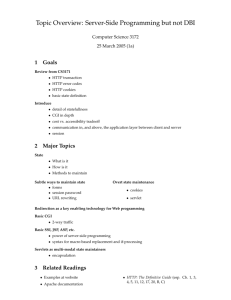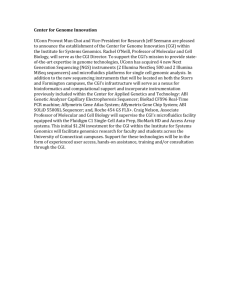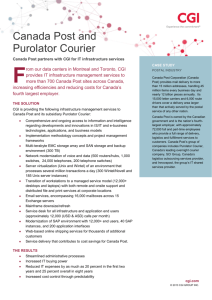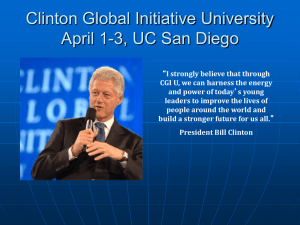Emerging Trends in Green IT
advertisement
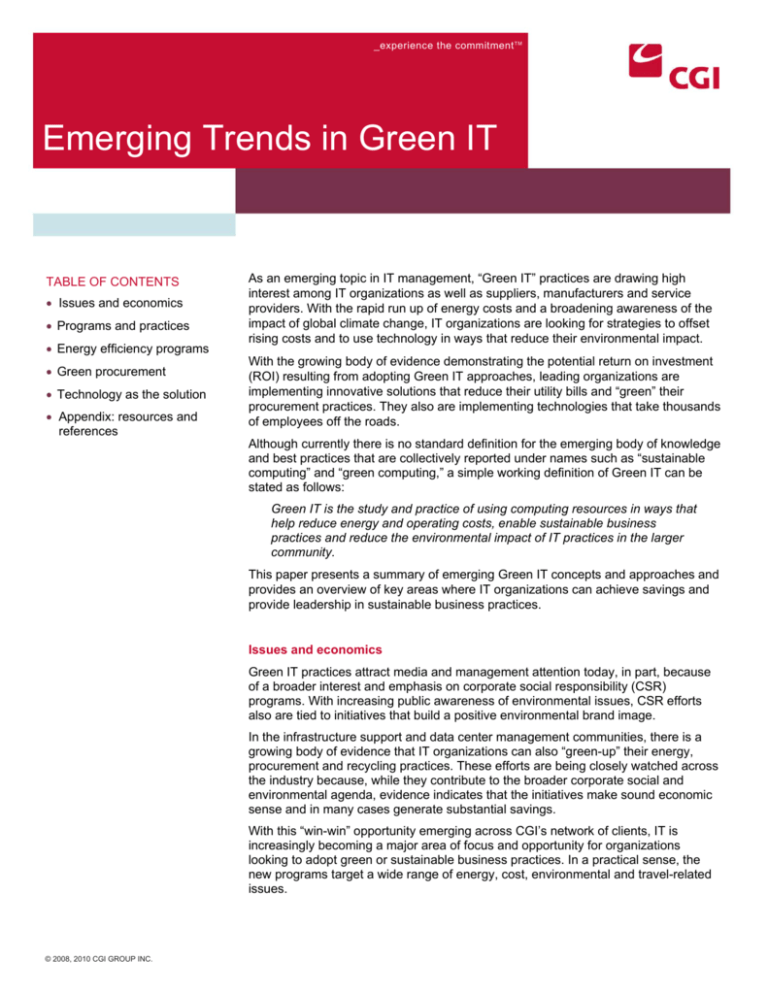
_experience the commitment TM Emerging Trends in Green IT TABLE OF CONTENTS • Issues and economics • Programs and practices • Energy efficiency programs • Green procurement • Technology as the solution • Appendix: resources and references As an emerging topic in IT management, “Green IT” practices are drawing high interest among IT organizations as well as suppliers, manufacturers and service providers. With the rapid run up of energy costs and a broadening awareness of the impact of global climate change, IT organizations are looking for strategies to offset rising costs and to use technology in ways that reduce their environmental impact. With the growing body of evidence demonstrating the potential return on investment (ROI) resulting from adopting Green IT approaches, leading organizations are implementing innovative solutions that reduce their utility bills and “green” their procurement practices. They also are implementing technologies that take thousands of employees off the roads. Although currently there is no standard definition for the emerging body of knowledge and best practices that are collectively reported under names such as “sustainable computing” and “green computing,” a simple working definition of Green IT can be stated as follows: Green IT is the study and practice of using computing resources in ways that help reduce energy and operating costs, enable sustainable business practices and reduce the environmental impact of IT practices in the larger community. This paper presents a summary of emerging Green IT concepts and approaches and provides an overview of key areas where IT organizations can achieve savings and provide leadership in sustainable business practices. Issues and economics Green IT practices attract media and management attention today, in part, because of a broader interest and emphasis on corporate social responsibility (CSR) programs. With increasing public awareness of environmental issues, CSR efforts also are tied to initiatives that build a positive environmental brand image. In the infrastructure support and data center management communities, there is a growing body of evidence that IT organizations can also “green-up” their energy, procurement and recycling practices. These efforts are being closely watched across the industry because, while they contribute to the broader corporate social and environmental agenda, evidence indicates that the initiatives make sound economic sense and in many cases generate substantial savings. With this “win-win” opportunity emerging across CGI’s network of clients, IT is increasingly becoming a major area of focus and opportunity for organizations looking to adopt green or sustainable business practices. In a practical sense, the new programs target a wide range of energy, cost, environmental and travel-related issues. © 2008, 2010 CGI GROUP INC. Business solutions through information technology® _experience the commitment TM Among the issues most commonly reported, and those that appear to be fueling the Green IT movement, are the following: • Rising energy demand with a more limited supply and increasing utility costs • Management of hazardous waste and electronic equipment disposal (e-waste) • Increasing gasoline costs, which drive up employee commuting costs leading to retention issues • Increasing real estate costs • Rising airline ticket costs and travel complexities • A stronger regulatory climate at the federal, state and local levels Programs, practices and processes The need to take action to address this growing list of business and environmentally linked issues is driving a wide range of thinking and problem-solving activities. New initiatives are reported from all segments of the industry, including businesses, government, computer manufacturers and service providers. Global enterprises also are being driven by toughening regulations adopted by the European Union. As a result, many IT organizations are looking at Green IT programs to achieve objectives that include improving energy efficiency and power management practices, increasing hardware utilization, reducing life-cycle costs and looking for ways to cut down on computer waste. The major areas of activity associated with these programs fall generally into three categories: • Energy efficiency programs: These programs focus on maximizing energy use and computing efficiency in the IT infrastructure and data center levels to reduce energy consumption, electric utility costs and associated global greenhouse gas impacts. • Power consumption: This category includes efficient approaches to power conservation. For instance, as part of CGI’s technology infrastructure management offering, CGI’s ongoing data center electromechanical improvement program combines methods, processes and energy-focused solutions for power and cooling efficiency. For example, CGI data centers use raised floor lighting and cooling retrofits to orient projects toward energy conscious and cost-saving solutions. Using current and efficient power consumption technologies has enabled the centers to reduce utility inefficiency and waste by right-sizing to new, more efficient cooling and power solutions. • Cooling: By leveraging local climates and using chilled loop and free cooling strategies, IT organizations can decrease energy consumption through cooling practices. For example, CGI has decreased energy consumption with its own data center cooling strategies. Through the use of dual, air-cooled, split-type screw chillers, N+1 redundancy is achieved. This use of innovative, green, renewable energy resources enables CGI to reduce its demand for electricity, which also relieves the pressure on already over-burdened local electricity grids. www.cgi.com Business solutions through information technology® _experience the commitment TM FAST FACTS • A business with a network of 20,000 desktop systems running 24 x 7 drawing 200 watts will consume about 35 million kWh of electricity annually. Using the average U.S. cost of electricity at $.0855/kWh, this would cost this business approximately $3 million in utility charges annually. • An estimated 90% of workstations in use on any given day have their energy conservation features disabled. • On a base of 20,000 workstations, implementing power management policies and standards would represent an annual savings of between $900,000 on the lower-end 60 watt devices and up to $2.4 million on a base of higher-end devices annually. • The Canadian Teleworker Association (CTA) estimates that organizations can save, on average, one office per three teleworkers at an average real estate cost of $2,000 per teleworker per year. For more information, visit the appendix resources and references section at the end of the paper. • Green procurement and asset management: This category includes initiatives that focus on purchasing computing equipment that is more energy efficient and environmentally friendly and includes programs to extend equipment useful life, recycle and engage with suppliers that demonstrate a commitment to reducing hazardous materials in their manufacturing, packaging and factory waste management programs. • Technology-based solutions: This category includes programs that employ technology in ways that are designed to reduce travel, commuting and real estate costs along with the environmental impacts of jobs related to people movement. Energy efficiency program development When PC visionaries Bill Gates and Steve Jobs set out to put a computer on every desktop back in the 1980s, no one could have imagined the millions of computers that drive billions of business, consumer and personal internet transactions across a global network each day. With an average desktop computer and monitor consuming between 60 and 300 watts of electricity, it is not surprising that energy consumption and cost reduction programs represent a major area of focus and opportunity within Green IT. Thought leadership on how to approach the energy efficiency problem is now coming from both private companies and government entities, as well as from core IT product and services companies such as Google, Intel, Dell, Microsoft, HP, Sun and many others. Power usage and associated cost reduction programs are also a major area of focus for CGI’s Green IT service development efforts due to the strong ROI potential this area represents for our clients. Running the numbers Today we know that, depending on local utility rates, a computer and monitor left running 24 x 7 x 365 drawing 60 watts will consume about $50/year in electricity, while a higher-end 300 watt device will cost about $225/year (based on an average U.S. utility rate of $.0855/kWh). To a small business or homeowner looking at energy costs, these numbers are not large, nor are they the kinds of numbers that tend to stimulate immediate action. It is perhaps for this reason we find that business and homeowners give little thought to leaving their desktop PCs powered up with their screensavers running 24 hours-aday. The cumulative impact, however, when looked at from the perspective of the electrical drain created by a medium-sized business or community presents an entirely different picture. A business with a network of 20,000 desktop systems, for example, running 24 x 7 drawing an average of 200 watts will consume about 35 million kWh of electricity annually. Using the average cost of electricity of $0.0855, this practice will cost the company about $3 million in utility charges annually. www.cgi.com Business solutions through information technology® _experience the commitment TM The climate savers computing initiative In 2007, recognizing the implications of these energy consumption numbers when projected on a global scale, Google and Intel launched a public awareness program called the Climate Savers Computing Initiative (see the appendix section at the end of the paper). Many people today, for a variety of reasons, look at their computer power consumption as a fixed cost that is largely beyond their control. This perception, or misperception, as it turns out to be, served as one of the primary motivators for the formulation of the Climate Savers group, which now includes industry giants such as Dell, Microsoft and HP. Promoting the idea that individuals and businesses currently have at their fingertips several simple, low-cost options that can immediately reduce their power demand, Climate Savers is attempting to inform and modify behavior through their power management awareness program. The program promotes the use of both policies and best practices, including using the power management features that are available on most computers today. The group reports on their website that an estimated 90% of workstations in use on any given day have their energy conservation features disabled. Of devices that have their power management settings activated, many have a screensaver running that can prevent the power management settings from being automatically engaged. By establishing programs that require screensavers to be disabled, standards for configuring power management settings and best practices that require devices to be powered off when not in use, Climate Savers estimates that power usage could be reduced by an estimated 60-80%. A working example of the ROI of best practices At the average utility rate used in the example above, industry data now suggests that annual savings of between $30 and $80 per workstation can be reasonably achieved. On a base of 20,000 workstations, implementing power management best practices would represent an annual savings of $900,000 on the lower-end 60 watt devices and up to $2.4 million on a base of higher-end devices. For mid-to-large IT operations in particular, developing an energy reduction program that may include implementing a centrally managed power management software product can be well worth the effort and licensing investment. A recent study involving a large financial institution reported an average savings of $66 per device for a total of $3 million in savings in reduced utility charges annually. Through their efforts to improve awareness, and by demonstrating this type of direct expense reduction opportunity, the Climate Savers group has targeted a reduction in global computing energy usage of 50% by 2010. Green procurement and supply chain programs Recent regulations such as the European Union’s “Reduction of Hazardous Substances” directive (RoHS) and the “Waste Electrical and Electronic Equipment” directive (WEEE) have aggressively set what is becoming a de facto global standard www.cgi.com Business solutions through information technology® _experience the commitment TM for computing manufacturers. These regulations restrict the use of hazardous materials such as lead, mercury and cadmium in the computer manufacturing and packaging processes and are driving improvements in design for recyclability. The new regulations also are requiring manufacturers to create take-back programs where they must accept responsibility for recycling their products at end-of-life. For global suppliers like Dell, HP, Sun and IBM, meeting these regulatory requirements for the European markets also means extending the environmental benefits into the major markets of North America and Asia. EPEAT In the United States, a product registry called the Electronic Product Environmental Assessment Tool (EPEAT) has begun to establish itself as a major force in Green IT procurement. EPEAT is a federally sponsored initiative that uses 51 environmental product compliance requirements that were developed through an industry group led by the Institute of Electrical and Electronic Engineers (IEEE). Under the program, suppliers can register their desktop, laptop and monitor products in 23 mandatory and 28 optional categories. Products that meet the appropriate combinations of mandatory and optional criteria can then be registered in either the basic, bronze, silver or gold rating categories. For purchasers, EPEAT offers guidance for assessing the trade-offs of cost versus performance across a broad range of devices. There are currently over 900 products in the registry with more being added weekly. EPEAT also provides guidance on performance criteria for the design of new products and provides an opportunity for manufacturers to gain market visibility and recognition for their efforts in reducing the environmental impact of their products. Although it is a voluntary program, the organization operates a verification process to assure the credibility of product listings in the registry. While the IEEE standards currently cover only PCs and monitors, the program is reportedly being extended to cover other devices such as servers, routers and printers. In addition to the product registry, EPEAT also provides an assessment tool to help purchasers compare and select equipment best matching their procurement needs. The tool can be used to compare power costs between devices. It can also be used to help develop the business case for replacing older generation devices such as CRTs with newer, more power efficient equipment. Technology as the enabler Two of the hottest areas to come under recent scrutiny by CGI clients are the escalating costs of corporate travel and employee commuting costs. Rising airline ticket prices and concerns over employees “jumping ship” to cut down on long commutes have resulted in many organizations looking at options such as telecommuting and teleworking and deploying the newer IP-based "telepresence” solutions. With airline ticket costs rising and flight cancellations and delays www.cgi.com Business solutions through information technology® _experience the commitment TM increasing, business travel has become more of a burden on both organizations and individuals. As an alternative to flying personnel to meetings, companies are turning to technology-based solutions to bring down their travel costs. In some cases, older technologies such as teleconferencing and videoconferencing are being put into more active use. In other cases, organizations are implementing solutions that capitalize on mobile, IP, web and video-based technologies. A few of the more common that underpin Green IT travel reduction strategies include the use of webenabled voice and video conferencing using meeting-ware products to provide presentation sharing and discussion capability. New in this area of technology are the enhanced, IP-based videoconferencing “telepresence” solutions that use large flat panel monitors with full-motion video and life-sized images to create a lifelike, real-time, meeting experience. While these solutions are targeted more toward reducing air travel costs, other initiatives focus on technologies that enable employees to work remotely to cut down on daily commute time and costs. In addition to their impact on global greenhouse gas emissions, these programs are designed to improve loyalty and morale, thereby improving productivity and overall retention. Technologies such as teleconferencing and web-based meeting capability are also heavily in play here, as are other options including: • Remote access software to enable file sharing, web access and email • Mobile computing, phones, Internet access, text messaging, instant messaging and email • Collaboration software products such as Microsoft SharePoint and Exchange/Outlook Home office programs By deploying the types of technology-enabled solutions discussed above, businesses and governments are able to implement a broad range of scheduling and work location options for employees. Popular programs that take people off the roads and reduce commuting and related auto maintenance costs include: • Telecommuting from home one or more days per week • Full-time home-based employees who share temporary offices at the corporate site when required for meetings, eliminating the need for a permanently assigned corporate workspace • Working from remote or decentralized office facilities that are closer to the employees’ homes to reduce commute times and distances The Canadian Teleworker Association (CTA) estimates that organizations can save, on average, one office per three teleworkers, at an average real estate cost of $2,000 per teleworker per year. As discussed in the power management cost reduction examples above, these numbers only become compelling when viewed in the context www.cgi.com Business solutions through information technology® _experience the commitment TM COMPANY PROFILE At CGI, we’re in the business of satisfying clients by helping them win and grow. For more than 30 years, we’ve operated upon the principles of sharing in clients’ challenges and delivering quality services to address them. As a leading IT and business process services provider, CGI has a strong base of 26,000 professionals operating in more than 100 offices worldwide, giving us the competitive advantage of close proximity to our clients. Through these offices, we offer local partnerships and a balanced blend of global delivery options to ensure clients receive the optimal combination of value and expertise required for their success. We define success by helping our clients achieve superior performance and gain competitive advantage. of their cumulative effect. From the larger perspective, real estate savings can rapidly add up. Sun Microsystems, for example, has recently estimated that their telecommuting programs have reduced their requirement for office space by about 6,000 office seats. Based on the CTA numbers, this would represent a real estate expense offset of $12 million annually. By aggressively pursuing telecommuting, home office and other employee-focused programs, Sun estimates an overall cost reduction of approximately $63 million annually. Sun also reports through their website that employees are saving an average of 108 hours of commuting time per person annually and that these programs have cut employee gas and car repair costs significantly. Sun and other companies offering these types of flexible scheduling and remote worker programs report higher employee satisfaction levels, which they believe translates into higher employee retention and lower turnover rates. Conclusion The approaches, strategies and solutions discussed above are gaining broad industry awareness and appeal. The following table presents a summary of some of the emerging data that is fueling the development of Green IT practices. UN estimate of computer and cell phone equipment dumped into landfills in 2006* UN estimate of e-waste recycled in 2006* Computers in use with power management features disabled** Estimated energy savings by using the power management setting “standby”** Approximate cost of running a desktop 24 x 7 x 365** Approximate annual savings per PC using power management best practices** Estimated savings on a base of 20,000 devices 20–50 million tons 12% 90% 60–80% $125 $30–80 $600K–$1.6M *Source – UN data **Source – Climate Savers Computing Initiative Green IT practices—including exciting new efforts in the major area of data center power utilization—are earning a place on the corporate agenda, and implementation of these programs is clearly within the reach of most enterprises today. Because Green IT programs are demonstrating fundamental economic as well as environmental sense, it is understandable why organizations are exploring green computing options with such intense interest across the IT industry. As more and more companies include some form of reporting on their goals and achievements in the area of CSR, there is a growing awareness among business leaders that greening their IT practices offers the “double-win” of reducing costs while demonstrating a positive environmental commitment. www.cgi.com Business solutions through information technology® _experience the commitment TM APPENDIX: Resources Below is a sampling of environmental initiatives discussed in the paper with brief descriptions of the organizations drawn from their websites. Climate Savers Computing Initiative: “Started by Google and Intel in 2007, the Climate Savers Computing Initiative is a non-profit group of eco-conscious consumers, businesses and conservation organizations. Our goal is to promote development, deployment and adoption of smart technologies that can both improve the efficiency of a computer’s power delivery and reduce the energy consumed when the computer is in an active state.” http://climatesaverscomputing.org EPEAT: “EPEAT is a system to help purchasers in the public and private sectors evaluate, compare and select desktop computers, notebooks and monitors based on their environmental attributes. EPEAT also provides a clear and consistent set of performance criteria for the design of products, and provides an opportunity for manufacturers to secure market recognition for efforts to reduce the environmental impact of its products.” http://www.epeat.net Energy Star: “Energy Star is a joint program of the US Environmental Protection Agency and the US Department of Energy helping us all save money and protect the environment through energy efficient products and practices.” http://www.energystar.gov United States Climate Action Partnership: “USCAP is a group of businesses and leading environmental organizations that have come together to call on the federal government to quickly enact strong national legislation to require significant reductions of greenhouse gas emissions. USCAP has issued a landmark set of principles and recommendations to underscore the urgent need for a policy framework on climate change.” http://www.us-cap.org US National Academies Board on Atmospheric Sciences and Climate (BASC): “The Board seeks to advance understanding of the Earth's atmosphere and climate, to help apply this knowledge to benefit the public, and to advise the federal government on issues within the Board's areas of expertise. The Board carries out its mission through the activities of specialized committees and panels charged with providing cogent and independent advice on critical scientific issues, from narrowly defined, highly technical problems to broad public policy concerns.” http://dels.nas.edu/basc ICLEI - Local Governments for Sustainability: “(ICLEI) is an international association of local governments as well as national and regional local government organizations that have made a commitment to sustainable development. Over 955 cities, towns, counties, and their associations worldwide comprise ICLEI's growing membership. ICLEI works with these and hundreds of other local governments through international performance-based, results-oriented campaigns and programs.” http://www.iclei.org www.cgi.com Business solutions through information technology® _experience the commitment TM APPENDIX: References 1. 2. 3. 4. 5. 6. 7. 8. 9. 10. 11. 12. 13. 14. 15. 16. 17. 18. 19. 20. 21. 22. 23. 24. 25. 26. A Call for Action, United States Climate Action Partnership, January, 2007 “A Five Step Program for Sustainability,” by John Davies, AMR Research, December, 2007 “Best Practices for Data Centers: Lessons Learned from Benchmarking 22 Data Centers,” by Steve Greenberg, Evan Mills and Bill Tschudi, Lawrence Berkeley National Laboratory, 2006 “Build a Green Data Center,” by Dave Ohara, TechNet Magazine, October, 2007 Climate Savers White Paper, Climate Savers Computing Initiative, November 30, 2007 Cost Containment Discussion, United States Climate Action Partnership, March 20, 2008 Electronic Industry Code of Conduct Version 2.0, EICC, October, 2005 Enforcement of the Restriction of Certain Hazardous Substances in Electrical and Electronic Equipment Regulations(RoHS), European Union, UK National Weights and Measures Laboratory, November 2007 “Getting to the Bottom of the ‘Triple Bottom Line,’” by Wayne Norman and Chris McDonald, Business Ethics Quarterly, March 2003 “Give Telecommuting the Green Light,” by Ted Samson, InfoWorld, November 21, 2007 “Green Computing Picks Up Momentum,” by Bert Latamore, Computer World – Networking & Internet, January 4, 2008 “IBM Launches Green Energy Tools for Data Centers,” eWeek/Reuters, April 30, 2008 IEEE Standard 1680, Section 4, Environmental Performance Criteria, IEEE “IT For Green – A Call to Action for the CIO,” by Jill Feblowwitz, Kimberly Knickle, Leslie Hand and Meredith Whalen, Energy Inisghts, June 2008 “Reap the Rewards of Hardware Recycling,” by Leon Erlanger, InfoWorld, July 12, 2007 “Seeing Green,” Consulting Magazine, April 29, 2008 Solutions for Sustainable Communities, ICLEI – Local Governments for Sustainability “Sun, Employees Find Big Savings for Open Work Telecommuting Program,” by Ted Samson, InfoWorld, June 19, 2007 “Survey the Green-Tech Landscape,” by Ted Simpson, InfoWorld, November 21, 2007 “Telepresence Breaks Down Communication Barriers,” by Ted Samson, InfoWorld, June 21, 2007 “The Business Case for Green IT,” by Steve Brasen, Enterprise Management Associates (EMA) 2008 “The Dawn of Green IT Services,” Forrester Research, March 4, 2008 “The Greening of IT – Analyst Perspectives,” April 2008 “The Value of Green – A Case Study of Hewlett Packard’s Social and Environmental Responsibility Strategies in Supply Chain,” by Kevin O’Marah and Eric Karofsky, AMR Research, June 2006 “Understanding and Responding to Climate Change, Highlights of the National Academies Reports,” The National Academies, USA, March 2008 “Understanding Your Vendor’s Supply Chain Is Key to Green IT Strategy,” Deborah Grove, GreenerComputing, January, 2008 www.cgi.com

